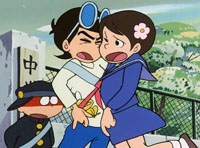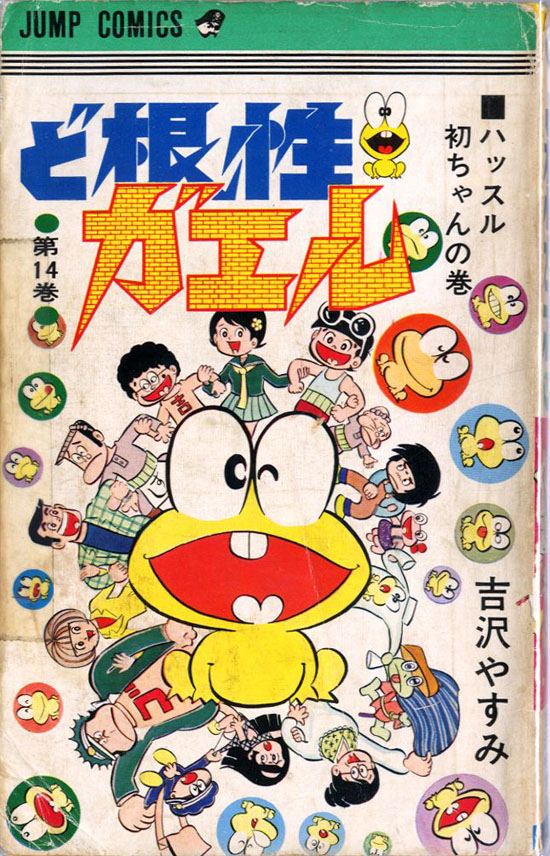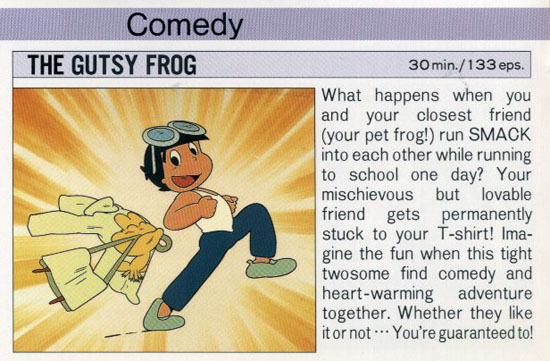
As a child living in Japan, I was enamored by a cartoon there called Dokonjo Gaeru, also known as The Gutsy Frog (the official English name for trademark and licensing purposes, even though the show was never dubbed in that language).
The premise is simple: A middle school boy named Hiroshi trips and falls to the ground, accidentally landing on a frog that happened to be in the way. As a result, the frog is stuck to the shirt. Miraculously, the frog not only survived, but he can talk as well. He calls himself Pyonkichi and the two became friends. And thus the series was born.
 That story may be off-the-wall for Western animation fans, but it was bread-and-butter for the Japanese folks. It was part of the formula that many cartoons there had, where a boy becomes friend with a strange companion, which can be a ghost (Obake no Q-Taro), a monster (Oraa Guzura Dado, Kaibutsu-kun), a genie (Hakushon Daimao), a robot (Doraemon), or whatever. However, Dokonjo Gaeru stood out on two fronts:
That story may be off-the-wall for Western animation fans, but it was bread-and-butter for the Japanese folks. It was part of the formula that many cartoons there had, where a boy becomes friend with a strange companion, which can be a ghost (Obake no Q-Taro), a monster (Oraa Guzura Dado, Kaibutsu-kun), a genie (Hakushon Daimao), a robot (Doraemon), or whatever. However, Dokonjo Gaeru stood out on two fronts:
1. All the characters lived in poverty. The reason Hiroshi always wears that same shirt is because he’s poor. He can’t afford to have another shirt, so he’s stuck with Pyonkichi no matter what. In fact, just about every character in this show are lower-class. The only mid-to-upper class character is Hiroshi’s girlfriend, Kyoko.
2. The series represented the rougher side of being a kid in suburban Tokyo. Hiroshi always got into fights with the neighborhood bully Gorilla-Imo, and the show never shied away from violence. Even when it’s disguised in the form of “cartoon slapstick”, things can go rough for the characters, which made it stand out from other cartoons in the genre.
 The series was enjoyed by kids of all ages, but it was primarily aimed at teenagers, and reading the points above, it’s easy to see why they would find it appealing. Nothing was sugar-coated; being a kid ain’t easy and the show didn’t shy away from it. It featured the highlights and the lowlights of growing up in Japan.
The series was enjoyed by kids of all ages, but it was primarily aimed at teenagers, and reading the points above, it’s easy to see why they would find it appealing. Nothing was sugar-coated; being a kid ain’t easy and the show didn’t shy away from it. It featured the highlights and the lowlights of growing up in Japan.
The comic first appeared in Weekly Shonen Jump in 1970. Its creator, Yasumi Yoshizawa, was only 20 years old when it debuted. It was later picked up by Tokyo Movie for an animated series, which aired on ABC (Asahi Broadcasting Corporation) starting October 7, 1972. The show ran for two years on its 7 PM Saturday evening time-slot, ending on September 28, 1974. 103 episodes, each divided into two shorts, were made altogether.
The anime was one of the many early successes for the Tokyo Movie company, who entrusted A Production to handle the animation. The Tokyo Movie/A Production team-up is the best thing to happen in the early days of Japanese TV cartoons. As with all TV anime, the animation is very limited, with drawings often exposed on-threes. However, the designs, layouts, and key poses are very effective and well done. The characters are very expressive, ranging from wacky cartoon to pure, emotional sentiment. The animators knew they had to keep the cel count low, so they compensated by exaggerating the characters’ emotions and key poses, and it worked really well with Gaeru, a very cartoony but emotionally-driven show. Special credit should be given to Osamu Kobayashi and Tsutomu Shibayama, the show’s animation directors, for the style.
 As far as the other people involved in this show, Eiji Okabe was the supervising director for the first eight episodes. Starting with episode 9, Tadao Nagahama took over as the chief director. One interesting note is that Hayao Miyazaki initially did the storyboards for the first episode, only to be scrapped; Nagahama redid the boards and he ultimately received screen credit for it.
As far as the other people involved in this show, Eiji Okabe was the supervising director for the first eight episodes. Starting with episode 9, Tadao Nagahama took over as the chief director. One interesting note is that Hayao Miyazaki initially did the storyboards for the first episode, only to be scrapped; Nagahama redid the boards and he ultimately received screen credit for it.
In 1981 the property was revived with in new show called Shin Dokonjo Gaeru (The New Gutsy Frog), which ran for 30 episodes on Nippon Television and, again, produced by Tokyo Movie Shinsha. The show was a failure, alas. The animation in the new show didn’t work; it was quite poorly drawn, and the magic that made the original series great wasn’t there. The newer show is hardly talked about nowadays, even though Dokonjo Gaeru is still fondly remembered.
Here are some video links:
OPENING AND CLOSING SONGS
The show had two opening titles and three ending titles during its run. This video collects all of them.
FIRST EPISODE (Complete – in Japanese)
Vintage issue of Weekly Shonen Jump:

Series description from English TMS product catalog distributed to TV programmers at International Television Sales conferences:



 Charles Brubaker is a cartoonist originally from Japan. In addition to his work for MAD Magazine and SpongeBob Comics, he also created Ask a Cat for GoComics. You can also follow him on his Tumblr page.
Charles Brubaker is a cartoonist originally from Japan. In addition to his work for MAD Magazine and SpongeBob Comics, he also created Ask a Cat for GoComics. You can also follow him on his Tumblr page.











































This aired in Spain -also in Mexico, Chile and probably other Spanish-speaking countries as well- in the early 90’s as “La Rana Valiente” and it was a really fun show to watch; I certainly wish they reissued it on DVD. Oddly enough, while in the Spanish dub most characters retained their original names, Pyonkichi became “Raponchi”.
Sounds like they were making the name workable as a pun in Spanish if that was the case.
I actually just watched episode one dubbed in Spanish on YouTube. I understand a little Spanish so I could get the gist of what was going on without subtitles. It looks like a really fun show! I definitely got a Doraemon vibe from it. And I was impressed with the quality of the animation as well – it doesn’t make any pretense of being “realistic” but definitely gets the job done.
Props also for that first episode to writer Masaki Tsuji, a legendary screenwriter and novelist who has written for probably hundreds of scripts for anime TV series and movies since the early sixties. He’s written for every kind of show you can imagine – from gag comedies like this one, Doraemon, Dr. Slump and Urusei Yatsura, to shojo dramas like Honey Honey’s Wonderful Adventure and various early magical girl shows, to horror-action like the original Devilman TV series – and nails them all.
I could imagine Nickelodeon running this in the 80’s it’s just unfortunate that it never did. The entire series seems to be available on Hulu Japan. It sure looks much more cartoony and fun compared to anything being produced for TV over here in 1972.
It would be nice had it happened. There’s a lot of Japanese toons that missed out simply because cable broadcasters weren’t too into trying to play what might not be profitable to them at all (though in the 80’s it didn’t stop a few from coming over I use to see). They were far more liberal times in the 80’s and a show like The Gutsy Frog might’ve proved pretty unique if it was something you could only watch on Pay TV then. Of course Fred Patten already discussed home video’s gift to anime a while back, I think cable TV should get some accolades for what it tried to be too before the corporate powerhouses had their way sooner or later.
Nice post Charles!
I quite like the style of Gutsy Frog. Was it unique or was it fairly common for the time?
Somewhat common with TMS at the time. It was, more or less, their “house style” of the era. Although I think “Frog” was the first to use it.
@CHARLES BRUBAKER
“Somewhat common with TMS at the time. It was, more or less, their “house style” of the era. Although I think “Frog” was the first to use it.”
For me, first seeing what Gutsy Frog looked like, I reminded myself of TMS’s famous “Panda Kopanda” shorts released around the same time (a.k.a. “Panda! Go Panda!”). Both were A Pro works written by Hayao Miyazaki and directed by Isao Takahata but they have a style that nearly matches the look of Gutsy Frog (namely in the secondary characters) that confused me at first thinking maybe Miyazaki had something to do with that show. Interesting Miyazaki did the first episode’s storyboards, I wonder what he had in mind in boarding the show before leaving it?
Great article, Charles! THE GUTSY FROG was a fun show!
BTW, would Asahi Broadcasting Corporation be the same channel as TV Asahi (called NET at the time this series aired)?
No, Asahi Broadcasting Corporation and TV Asahi (originally NET, or Nihon Educational Television) are two separate broadcasters.
“No, Asahi Broadcasting Corporation and TV Asahi (originally NET, or Nihon Educational Television) are two separate broadcasters.”
Also of note, ABC is located in Osaka, not Tokyo.
Vintage issue of Weekly Shonen Jump:
Not exactly an issue, but a whole volume of the manga Shueisha released (known as a “tankōbon”, we would call this a “Graphic Novel” or perhaps “Trade Paperback” here). The “Jump Comics” banner on top was/is used on most tankōbon releases of those titles that were featured in Weekly Shonen Jump or other Jump imprints of Shueisha. The scan appears to suggest this is Vol. 14 in the series.
Sounds like Miyazaki had briefly jumped on board after working on Lupin the 3rd’s first TV series which ran from 1971-72.
TMS’ 70s output was something out of the ordinary, compare to the Scooby Doo rip offs that dominated the 70s (Zuiyo/Nippon Animation was the only other stand out in the 70s, after that they lost it as most of their best staff left for Telecom in 1977) it was something special, there was even a throw back to it in Superman Vs The Elite’s post intro opening (The US staff wanted it to look like Roger Ramjet, but TMS had other ideas, designs were left alone, but the style of it was changed to match that of Gusty Frog and Gamba, hears the link to it http://seirostuff.blogspot.com/2012/10/and-more.html ).
As for Gusty Frog Series 2’s animation, that might be because all of TMS’ good animators were doing Cobra at the time (came out in 1982), when Telecom (TMS’ A Pro replacement, but you might of already know that) was doing Zorro and Little Nemo at the time.
No doubt TMS has a good string of hits in the 70’s and 80’s that are either beloved or forgotten depending on your interests. I can see why the sequel to Gutsy Frog was done as careless as it was if they had more on their plate by then.
I’ve been hoping to see this series someday! It was included in a best of animation list made a few years ago during a festival in Japan. I find the visual style very appealing and I feel like I could take screencaps of it for hours (something I do with a lot of 70s anime for some reason!). Another thing I wish I could find is something called “Adventures of Ganba”, which I believe was done by the same studio.
Yep! “Ganba no Boken” was also done by Tokyo Movie. Osamu Dezaki directed that show. Very stylish!
Osamu Dezaki did a lot of things for TMS in those days. His work was very unique and diverse the number of shows he directed for the studio.
http://en.wikipedia.org/wiki/Osamu_Dezaki
How long did the magna lasted?
The manga lasted from 1970 to 1976, totaling some 27 volumes.
Great post, Charles! A while ago, I remember reading online about a voice actor who was supposedly doing voices for an English dub of “Gutsy Frog” (Dokonjo Gaeru). I’m not really sure if it was scrapped though.
Can you make your next post about the 70s anime Dame Oyaji? I’ve seen episodes of it online, and I wanted to learn more about its origins.
Reminded of another TMS production that did get an English dub for demo purposes, “Hajime Ninngen Gyatoruzu” (or “Giatrus, the First Man”). An English dub you can see here labeled the show as “The First Family” and was dubbed by a Canadian group.
http://www.tms-e.com/english/search/index.php?pdt_no=274